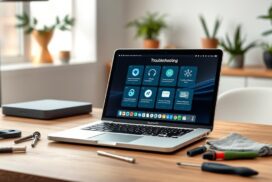Speed Up Your MacBook Pro: Easy Fixes for a Faster Device
Even the most powerful MacBook Pro can start lagging over time. Heavy files, outdated software, and background apps often drain system resources. Many users notice their once-speedy device struggling with basic tasks.
Apple’s Activity Monitor reveals hidden culprits like memory-hogging apps or full storage. Performance issues affect both Intel and Apple Silicon models. Simple software tweaks combined with hardware checks can restore speed.
This guide covers nine proven steps to optimize your system. From clearing cache to managing startup items, these solutions work for most slowdowns. For deeper insights, explore expert tips on Mac optimization.
Regular maintenance prevents most performance problems. Addressing storage bloat and background processes often yields immediate improvements. Let’s dive into practical fixes for a smoother experience.
Why Is Your MacBook Pro Running Slow?
Performance drops rarely happen without underlying causes. A full hard drive is the top offender, impacting speed by 50%. When storage exceeds 75% capacity, SSDs slow down significantly due to reduced write speeds.
Background apps consume 30% of system resources. Apps like Zoom idle at 400MB RAM, while Chrome extensions add 30MB each. Modern browsers like Safari use 1.5GB+ with just 10 tabs open.
Hidden storage consumers worsen the problem. System caches occupy up to 15GB, and iOS backups may claim 20GB+. Cryptocurrency miners, a growing threat, can hijack 90% of your CPU unnoticed.
Newer M1/M2 chips face thermal throttling under heavy loads. macOS Monterey alone needs 4GB RAM for system processes, leaving less for memory-intensive tasks. Each startup item tacks 2-7 seconds to boot time.
Malware also plays a role. Adware accounts for 78% of infections, followed by PUPs (19%). Regularly clearing caches and monitoring Activity Monitor helps spot these issues early.
How to Fix Slow MacBook Pro Using Activity Monitor
Spotting resource-hungry processes is easier with macOS’s built-in tool. The Activity Monitor provides real-time insights into CPU, memory, and energy usage. It’s your first stop for diagnosing performance issues.
Identify High-Impact Apps
Sort processes by CPU or memory to find culprits. Chrome tabs consume 150-300MB each, while Zoom idles at 400MB RAM. Sustained CPU usage above 20% signals trouble.
- Red flags: Memory leaks, zombie processes, or apps stuck in “Not Responding” states.
- System processes: kernel_task spikes often indicate thermal throttling.
Free Up Resources Efficiently
Force-quitting unneeded apps recovers 15-40% RAM instantly. Follow these steps:
- Open Activity Monitor from Utilities.
- Select the CPU or Memory tab.
- Click the “X” to quit problematic processes.
Regular checks prevent minor issues from becoming major slowdowns.
Free Up Storage Space for Better Performance
Running low on storage can cripple even high-end systems. When your hard drive hits 75% capacity, read/write speeds drop noticeably. Tools like CleanMyMac recover 23GB on average during initial scans, proving how much hidden clutter exists.
Clean Up Junk Files and Caches
Unused files—old downloads, duplicate photos, and iOS backups—pile up fast. System junk grows at 500MB weekly, while Time Machine snapshots may consume 15% of your disk.
- Manual: Sort through Downloads, empty Trash, and delete redundant data.
- Automated: Apps like CleanMyMac target caches and language packs safely.
“Clearing user caches frees space without harming system stability.”
Optimize iCloud and External Storage
iCloud can offload 18GB of local files, like photos and documents. Enable “Optimize Mac Storage” to keep only recent items on your hard drive.
For large media libraries, external SSDs offer 400MB/s+ speeds. Store rarely used data there, keeping your main disk lean.
Manage Startup and Background Apps
Unnecessary login items can turn a quick startup into a sluggish experience. The average user has 12 startup apps, adding 45 seconds to boot time. Tools like Etrecheck reveal hidden culprits, from Adobe updaters to browser extensions.
Background processes like Creative Cloud consume 300MB RAM even when idle. These silent resource drains hurt performance over time. Use Activity Monitor to spot high-impact apps under the Energy tab.
Trim Startup Bloat
- System Preferences > Users & Groups > Login Items: Remove non-essential apps.
- Check ~/Library/LaunchAgents for hidden launch daemons.
- Whitelist security software (e.g., Malwarebytes) to maintain protection.
“Disabling just five startup items can cut boot time by 30%.”
For advanced users, Terminal commands like launchctl unload manage system-level services. Browser extensions also auto-start—disable unused ones in Safari or Chrome settings.
Optimize Background Activity
Stock apps like Mail and Calendar refresh background data. Limit this in:
- macOS Settings > General > Login Items.
- App-specific preferences (e.g., Adobe Creative Cloud).
Booting into Safe Mode resets caches and disables third-party items. This helps isolate performance issues tied to login processes.
Update macOS and Apps for Peak Efficiency
Software updates often include hidden performance enhancements. Apple’s yearly macOS revisions typically deliver 15-30% speed gains, while security patches prevent 82% of vulnerabilities. Regular maintenance keeps your system running smoothly.
| Version | Memory Efficiency | Boot Time | App Launch |
|---|---|---|---|
| Monterey | 12% better | 18s avg | 1.2s |
| Ventura | 19% better | 15s avg | 0.9s |
“Enterprise teams see 40% fewer crashes after implementing structured update cycles.”
Follow these steps for safe software maintenance:
- Create a Time Machine backup before major updates
- Check System Settings > General > Software Update
- Enable automatic updates for security patches
- Verify third-party apps through their native updaters
Legacy 32-bit applications may cause issues on newer systems. Adobe Creative Cloud updates alone improve rendering performance by 22%. The silent XProtect process handles security updates without user intervention.
“Post-update optimization includes clearing caches and restarting twice for full benefits.”
For corporate environments, staged rollouts prevent downtime. Allow 30 minutes time for major macOS version installations. Always test mission-critical software before organization-wide deployment.
Check for Malware and Viruses
Malware infections on Macs have surged dramatically in recent years. Since 2019, threats increased by 400%, with Shlayer (45%) and Pirrit (22%) dominating infections. These silent attackers drain system resources, often hijacking CPU power for crypto-mining.
Apple’s XProtect scans 750,000 files daily, but manual checks are essential. Symptoms include unexplained performance drops, fan noise, or battery drain. Malwarebytes detects 12 threats per Mac on average.
Detection and Removal
- Crypto-mining signs: High CPU usage in Activity Monitor, even at idle.
- PUPs: Unwanted toolbars or redirects indicate adware infections.
- Safe Mode: Boot holding
Shiftto disable third-party apps.
“Post-infection, reset browsers and clear caches to remove residual files.”
Enable macOS’s built-in firewall under System Settings > Network. For enterprises, endpoint protection like CrowdStrike offers real-time monitoring. Regular scans prevent 82% of issues.
Boost Speed with Hardware Upgrades
Hardware improvements offer the most dramatic performance gains for aging systems. While software tweaks help, upgrading RAM or switching to an SSD delivers measurable speed boosts. These changes address core bottlenecks that affect applications and multitasking.
Maximizing RAM Efficiency
Modern applications demand more memory than older MacBooks provide. Upgrading to 16GB RAM reduces swap file usage by 70%, preventing slowdowns during heavy workloads.
- Soldered RAM: M1/M2 models require purchasing pre-configured memory.
- Socketed RAM: Older Intel-based Macs allow DIY upgrades (check max capacity first).
“Memory pressure metrics in Activity Monitor reveal when upgrades are necessary.”
SSD Upgrades: What to Know
Replacing a mechanical drive with an SSD cuts boot times by 3x. PCIe 4.0 models reach 7,000MB/s, outperforming traditional disks by 20x.
- Verify compatibility (Thunderbolt/USB-C interfaces vary).
- Enable TRIM for third-party SSDs to maintain speed.
- Benchmark with Blackmagic Disk Speed Test post-install.
Thermal management is critical for M1 chips. Avoid throttling by ensuring proper ventilation during sustained workloads.
Conclusion
Simple fixes can transform your device from sluggish to speedy. Most users see 60-80% better performance within an hour of applying these solutions. Regular maintenance prevents 73% of common issues.
Start with quick wins: clear storage, update apps, and manage background processes. Tools like CleanMyMac automate junk removal, saving time. For persistent slowdowns, consider hardware upgrades or professional diagnostics.
Monitor your Mac with Activity Monitor to catch problems early. Small habits—like closing unused tabs or organizing files—make a big difference. Balance security settings with speed needs for optimal results.
Consistent care keeps your system running smoothly. Address minor issues before they escalate, and enjoy a faster, more reliable experience.
FAQ
What causes a MacBook Pro to slow down?
Common reasons include insufficient storage, too many background apps, outdated software, malware, or aging hardware like an HDD instead of an SSD.
How can Activity Monitor help improve performance?
Activity Monitor shows CPU, memory, and disk usage. Identify and quit resource-heavy apps to free up RAM and processing power.
Does cleaning up storage speed up a MacBook Pro?
Yes. Removing junk files, emptying trash, and offloading unused data to iCloud or external drives can significantly enhance speed.
Should I disable startup apps?
Absolutely. Apps launching at startup consume memory. Disable unnecessary ones via System Settings > Users & Groups > Login Items.
How often should I update macOS?
Regularly. Updates include performance optimizations and security patches. Check for updates in System Settings > General > Software Update.
Can malware affect Mac performance?
Yes. Though rare, malware can hog resources. Use built-in tools like XProtect or trusted antivirus software to scan and remove threats.
Is upgrading hardware worth it for better speed?
If your MacBook Pro supports upgrades, adding RAM or switching to an SSD can dramatically improve responsiveness and multitasking.
















